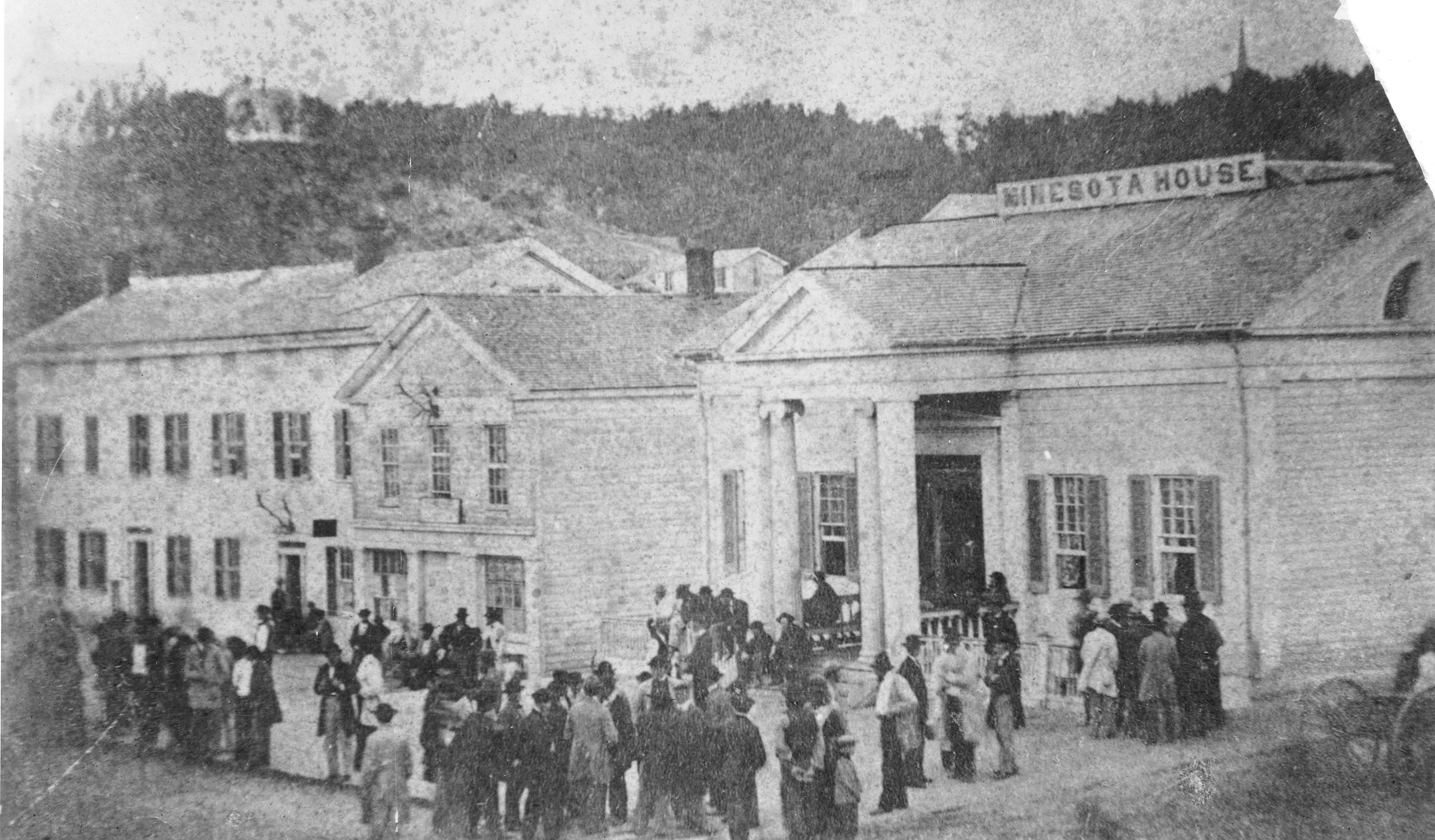Minnesota House Hotel
When Stillwater was an early lumber center, one of the most prominent landmarks was the Minnesota House Hotel.
Stillwater pioneer Elam Greeley constructed the Minnesota House in 1846 as a private residence at the corner of Main and Chestnut streets. After enclosing and roofing the building, it stood vacant for about a year before it was purchased by Orange Walker and Samuel Judd of Marine, who finished the structure as a hotel. A sign was placed atop of the building calling the new hotel the "Minesota House" with the name spelled differently than the name that would later be given to the territory and state. (Both spellings are English versions of the original Dakota phrase Mni Sóta Makoce.) Walker and Judd then rented the hotel to Harley Curtis to operate.
The hotel was very popular especially with its open patio in the front. There were two columns on either side of the entrance door and a covered area in the center of the building to enter. By August 1849, Curtis handed operations over to W.E. Hartshorn and advertisements of the change in the proprietors soon appeared in the St. Paul newspaper.
The advertisement read: "Minnesota House" "This commodious House, in the beautiful village of Stillwater, has been recently transferred to new hands. The establishment is now under the auspices of this gentlemanly proprietor [Hartshorn] assisted by my well known, highly esteemed and constantly obliging friend, Mr. Bostwick. This Hotel is well situated for the man of business as well as those sojourning for health or pleasure."
Hartshorn did not stay in the hotel business very long, in 1851 he sold the hotel to Gray and Trimble who then sold the hotel in 1855 to Samuel Burkleo. Burkleo sold the hotel a few years later and in 1860 the hotel was owned by John Darrah.
Darrah must not have done so well in the business. In the March 18, 1862 Stillwater Messenger it noted that the “Minnesota House – which has been closed for some time past – is being renovated, preparatory to a re-opening in a few days.” The new proprietor was from the old Wilson House hotel on Second Street, Mr. Ulrich Seigenthaler.
Seigenthaler retired from the business and sold the hotel to Mr. A. Ziegler in September 1865. Ziegler “intends to make thorough repairs, and refit the house throughout, and will, no doubt, maintain the former reputation of the house.”
In the Stillwater Republican of March 23, 1869, there appeared an advertisement for the Minnesota House to be sold. The hotel had "been recently refitted and furnished throughout, with beds, bedding and furnishings. The Hotel is located in the most central place in the city with a four years lease and is offered for sale on account of the failing health of the Proprietor. For further particulars inquire of John Gieret." The Minnesota House was sold the following week at a sheriff's auction for $3,549.23 to Kasper Burkart.
Again the hotel changed hands a short time later. Mr. Matthews, of St. Paul took possession of the hotel in August 1871. He, according to the Stillwater Weekly Gazette, will "immediately commence renovating, papering, painting, whitewashing and otherwise improving the building. He intends to have the house in first class order in a few weeks." Matthews also announced that the "popular assistant" Tommy Shay would remain working at the hotel.
By 1880, the Minnesota House was in such disrepair that it could no longer be a "public house" and was being used by the St. Croix Post and Publishing Company and also had a saloon in part of the building.
The St. Croix Post tried to keep up with repairs, however. In the March 19, 1881 Stillwater Messenger it stated that the Minnesota House was being re-roofed. The paper then gave a brief history of the building by saying that "This building was one of the first erected in Stillwater, and is probably older than any other building in the city now occupied as a residence. The old sign, "Minesota House," (spelled with one 'n'), which surmounted the roof, and which was painted when the spelling of the word had not been settled, or when sign painters were as little proficient in spelling as they are now, has been removed. There is no building in Stillwater whose destruction by fire will afford us so much pleasure in chronicling as the one in question."
The newspaper must have been happy when by 1883 the Minnesota House was torn down and replaced by the Tepess Block. A chapter of Stillwater's early history had come down, the first true landmark of the city reduced to nothing more than rubble.
—Brent Peterson
Brent Peterson is the Executive Director of the Washington County Historical Society.

